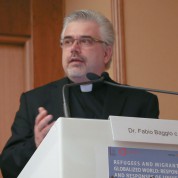PS1.4
Conflict, Crises, and Displaced Populations
25
Jan
Over the past several decades, the number of international migrants (people who are living outside of their country of birth) has reached 280 million, more than 3.5% of the world’s population. The negative impact of migration on geopolitics has become increasingly apparent.[1] Policies adopted with the intent of alleviating the pressure of increased migration on “recipient” countries seem to have failed everywhere, leading to an escalation of tensions around the problem, especially in high-income countries like the United States, the United Kingdom, and Western Europe. Considered together with the ongoing conflict in Eastern Europe (Ukraine), the longstanding humanitarian crisis in Afghanistan, political turmoil in the so-called “coup-belt” of Sahelian Africa, chronic ethnic and religious strife in Myanmar, increasing migration throughout the Americas for a variety of complex political, social, and economic reasons, and increasing, and truly worrisome climate emergencies, it is fair to say that no region of the world has been spared. Increasing political polarization, both a cause and an effect of migratory pressure, has led to the emergence of a seemingly unbridgeable chasm between those who favor a more humanitarian approach to the treatment of migrants and those calling for a further hardening of national borders. The result to date has been a shift of the balance of power to more right-wing and populist forces in an increasing number of countries and at least one government (the Netherlands) has fallen due to an inability of the governing coalition to reach a compromise position on this clearly inflammatory issue.[2]
Ironically, many economists hold that most migration that is motivated by a drive for economic advancement works to the benefit of both countries of origin and destination countries. Demographic trends are clear: high-income countries are aging rapidly, fertility rates are below replacement value, and many employment opportunities cannot be filled from within. Migrants from low- and middle-income countries either have needed skills that cannot be provided from domestic sources or are willing to provide necessary services that fill the emerging gaps. Examples include care provision for the elderly by Albanian migrants in Italy and by Somalis in Sweden, health care provision in the United Kingdom (where 1 in 6 staff of the National Health Service hold non-British nationality) and imported Mexican and Central American labor to help with agricultural work in the United States. Higher wages than migrants would earn in their countries of origin allow for the return of remittances that serve to elevate the standard of living for families and to augment government revenues. Of course, remittance policies can and should be reviewed and improved, but for the most part, at both ends of the migrant trajectory, “in the long run, economists and historians see a familiar picture: a spike in immigration stirs heated political debate, even as people who immigrate, both legally and illegally, begin to set down roots and start contributing economically.”[3]
For another class of migrants, refugees, legally defined as those having crossed an international border due to a well-founded fear of persecution for reasons of race, religion, nationality, political opinion, or membership in a particular social group, frequently in conjunction with armed conflict occurring in their country of origin, international law provides protection and rights in the country or countries of asylum. Most (but not all) countries are signatories to the 1951 Convention Relating to the Status of Refugees and/or to the 1967 Protocol. Clearly both documents, as well as additional agreements that govern the status of refugees in Africa and in South and Central America and the Caribbean, could be revisited, improved upon, and strengthened, but at least for the time being there seems to be widespread agreement regarding their ethical guidance and their ongoing usefulness, at least in theory if not always in practice.
In sum, as stressed by the World Development Report (2023, WDR), most drivers of migration are subject to either the forces of labor economics or of international law. Although the lines between different kinds of migrants are frequently blurred, most of the current problems seem to be primarily related either to economic migrants who do not possess the skills needed by destination countries, or by asylum seekers who are not eligible for or who have not been granted refugee status. While these “distressed migrants”, to use the language of the WDR, are a minority of all migrants, their number is sufficient to have already contributed significantly to important and influential changes on the geopolitical landscape and there are no signs of abatement. While the plight of these migrants who are often victimized by human traffickers and subjected to inhumane treatment in transit countries and at sea is inarguably deplorable, and while the manner in which they have been treated in their intended countries of destination has been roundly criticized by many, it is important to note that a sovereign nation is not obligated to grant entry to anyone who does not qualify for protection under an international agreement to which it, the recipient nation, is a signatory. The political system under which the world operates since at least the Peace of Westphalia of 1648 is not one of open borders, but rather one in which national sovereignty is prioritized.
Nevertheless, one might consider that, even if migrants’ petition for entry to a desired settlement country is denied, there remains a moral or ethical duty to treat all individuals humanely. The Universal Declaration of Human Rights (UDHR) is the foundational document of international human rights law; it has been commonly interpreted by the modern humanitarian movement as affording to all individuals the right to life with dignity, the right to receive humanitarian assistance, and the right to protection and security.[4] While it might be legal for recipient nations to bar entry to undocumented or “distressed” migrants, it is simply inhumane to turn a blind eye toward predatory human trafficking practices or towards horrific scenes of ships overloaded with families seeking a better life sinking in the Mediterranean Sea, or to potential asylum seekers having their families separated and being forced to stay in unfamiliar places where their lives are endangered. What has become a clear conflict between what is the law and what is basic humanitarian practice contributes to the political polarization that is an important geopolitical consequence of modern migration.
Regarding health, it is again the “distressed migrants” who pose the greatest problems. Both economic migrants and refugees who are granted visas to stay in recipient countries based on merit or other re-settlement programs usually have the right to access available host country health services and, in some instances, they have this right even if they are undocumented. In many instances, because of their place in the social structure of their countries of origin, the health status of those with sought-after specialized skills may have been, on average, as good as or even better than that of the population in the recipient countries. The same may be true of documented refugees, who often undergo health screening procedures and/or receive needed care prior to travel to their new country.
But the story is very different for the undocumented who “choose” to undertake long and arduous journeys to try to establish themselves in a country in which they do not have permission to reside or to work. For many, the conditions of travel take a toll – living for weeks or months without shelter, with inadequate access to food and water, often in crowded and unsanitary makeshift encampments, their state of health is bound to deteriorate. Even if they arrive at their destination safely, and even if they have legal access to health care, these undocumented migrants frequently opt to avoid contact with any part of the local bureaucracy for fear of being “discovered”, arrested, and possibly deported.
In public health, prevention is said to be preferable to cure and there have been several proposals advanced to reduce the flow of undocumented migrants, especially from low-income toward higher-income countries. These include the creation by recipient countries of more legal entrance mechanisms and/or reforming development policies to focus on reducing economic inequality in such a way as to lower the perceived incentives for migration. Additional international assistance to transit countries, especially those immediate pre-destination countries such as Tunisia, Turkey, Mexico, and many others, could help to alleviate the burden of unwanted migration on stressed social systems of some primarily recipient countries.[5] These are at best mid- to long-term partial solutions, however, and in the near-term it seems that more humane treatment of people in desperate straits is called for.
A special word is in order regarding “climate refugees” because of the increased attention appropriately being paid to this issue. As of now, most people displaced by adverse weather events that are increasing in both number and severity have remained within the borders of their countries of origin. Given current projections, however, the status quo will not endure, and some have predicted that more than 1 billion people will be displaced due to climate events over the next 25 years.[6] Increasing food insecurity and water insecurity, as well as the loss of shelter, has the potential to fuel social unrest, increasing violence, and political chaos. Climate change has led to scenes of a dystopic future becoming commonplace in many places around the world. Unfortunately, as has been the case with other drivers of migration, sensible and effective implementation of sound climate control policies have, to date, proven elusive.
Perhaps economic and political reactions to migration can be managed, at least in the medium-term, but there will always remain the seemingly intractable social consequences of unwanted, or feared, migration.[7] In the short-term, in many societies, expressions of xenophobia, racism, and religious intolerance seem to come to the fore when external threats to the established order, beneficial or not, are perceived. Declaring these attitudes to be unacceptable within a society or even illegal and subject to punishment does not seem to be an effective way of reducing their prevalence. To be sure, in some societies, they are even encouraged and supported by both political and religious leaders. In the future, for migration, especially “distressed migration” which is sure to increase over the next decades, to take a lesser toll on the geopolitical landscape, both societies and individuals will have to do things that they are not doing and think things that they are not yet contemplating.
What are those interventions that might be implemented in the short- and medium-term that can contribute to an abatement of the current crisis? As mentioned above, where migrants are performing important services in destination countries, reform of the remittances regime may contribute to increasing the financial security of a sizeable number of people in countries of origin and help to stabilize the current “direction of flow”. Because economic inequality is such an important driver of migration, re-designing existing development policies to put a premium on those areas of assistance and types of interventions that can be shown to have a mitigating impact on the perceived need of individuals and families to leave their homes to seek economic improvement could also be helpful. Reducing the number of inter- and intra-state conflicts and, as importantly, shortening their duration, could also reduce the numbers of refugees fleeing for protection and safety for themselves and their families although, of course, this is easier said than done and involves a different domain of geopolitical dynamics. Finally, it should be recognized that dealing with the consequences of migration, especially of “distressed migrants” is an international responsibility. Countries of origin, transit countries, and recipient countries should not need to struggle with these issues on their own. A stronger, more cooperative, and more effective international approach should be adopted in the near-term to stem the growing geopolitical crisis being caused by uncontrolled population movements.
[1] This concept note draws heavily on two principal sources: the World Bank’s World Development Report 2023 (https://www.worldbank.org/en/publication/wdr2023) and the UCL/Lancet Commission on Migration (https://www.thelancet.com/journals/lancet/article/PIIS0140-6736(16)31581-1/fulltext).
[2] BBC.com. Dutch coalition government collapses in migration row. https://www.bbc.com/news/world-europe-66139789 (accessed 27 July 2023)
[3] New York Times, July 13 2023. “As politicians cry “crisis”, some immigrants are finding their way”.
[4] Sphere Handbook (2018). Humanitarian Charter and Minimum Standards in Humanitarian Response.
[5] For more detail, see chapter 8, World Development Report, 2023.
[6] Institute for Economics & Peace. Over one billion people at threat of being displaced by 2050 due to environmental change, conflict and civil unrest. 2020. Available: https://www.economicsandpeace.org/wp-content/uploads/2020/09/Ecological-Threat-Register-Press-Release-27.08-FINAL.pdf.
[7] International Labor Office (ILO), International Office for Migration (IOM), and Office of the United Nations High Commissioner for Human Rights (OHCHR), in consultation with the Office of the United Nations High Commission for Refugees (UNHCR) (2001). International Migration, Racism, Discrimination, and Xenophobia.
Session 1.4 of the Prince Mahidol Awards Conference will expose the drivers of migration and discuss the different impacts that each might have on countries of origin, transit countries, and destination countries. It will discuss what has worked and what has not and will focus on the geopolitical consequences of current and predicted future trends. To the extent possible and practical, it will view issues of conflict, displacement, and economic crisis through the lens of public health and medicine. Finally, panelists and discussants will be encouraged to propose clear, implementable, and effective near-term, medium-term, and long-term solutions and to predict what human migration will look like to future generations.
PANELISTS
Biosketch
Dustin Barter
Ellen Hansen
Fabio Baggio
Federica Zamatto
Monette Zard
Ronald Waldman
Xavier Devictor
Short Paper
Session Materials
Federica Zamatto.pdf








